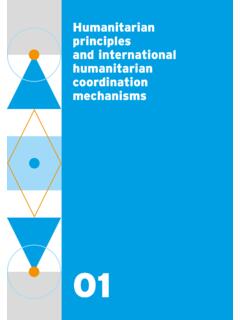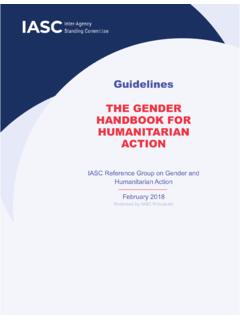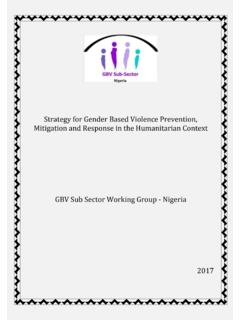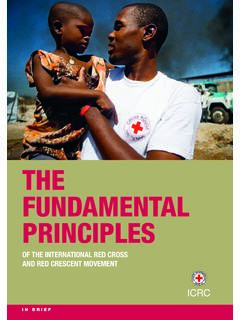Transcription of CORE COMMITMENTS FOR CHILDREN IN HUMANITARIAN …
1 I CORE COMMITMENTSFOR CHILDRENHUMANITARIAN ACTIONINFor more information, please contact: HUMANITARIAN Policy SectionOffice of Emergency Programmes, UNICEFP ublished by UNICEFD ivision of Communication3 United Nations PlazaNew York, NY 10017, USAE mail: : 978-92-806-5179-9 United Nations CHILDREN s Fund (UNICEF)October 202001 CORE COMMITMENTSFOR CHILDRENHUMANITARIAN Scope of The role of Performance International legal Global standards and HUMANITARIAN HUMANITARIAN Global HUMANITARIAN Guiding Centrality of Accountability to Affected Populations (AAP) Child Protection from Sexual Exploitation and Abuse (PSEA) Ethical evidence generation and data Institutional Commitment to deliver on the Emergency Risk Roles and Overarching Supply and HUMANITARIAN Protection from Sexual Exploitation and Abuse (PSEA) Accountability to Affected Populations (AAP)29 CONTENTS1 POLICIES, PRINCIPLES AND Administration and Human Information and communication technology (ICT)
2 Communication and Partnerships with governments andcivil society organizations for programme Resource Security Supply and Programme Quality of Multisectoral and integrated Linking HUMANITARIAN and Environmental sustainability and climate Community engagement for behaviour and social HUMANITARIAN cash Sectoral Needs assessments, planning, monitoring and Child Water, sanitation and hygiene (WASH) Social Cross-sectoral Gender equality and empowerment of girls and Early childhood development (ECD) Adolescent development and participation (ADAP) Situation-specific Public health emergencies (PHE) Large-scale movements of refugees, migrants and internally displaced persons801. Glossary1012. References1163. Acronyms1314. CCCs Indicator Guidance on Programme Commitments1335. CCCs Monitoring Framework for Operational Commitments1333 OPERATIONALCOMMITMENTS4 ANNEXES041.
3 Policies, principles and accountability1. POLICIES, PRINCIPLES AND ACCOUNTABILITY Introduction Since the Core COMMITMENTS for CHILDREN in HUMANITARIAN Action (CCCs) were introduced in 1998 and revised in 2010, the global HUMANITARIAN context has changed significantly. HUMANITARIAN crises are increasingly protracted. Rising disregard for international HUMANITARIAN and human rights law and HUMANITARIAN principles characterizes conflicts, disproportionally affecting CHILDREN and women. Population growth, urbanization, environmental degradation and climate change, large-scale migration, forced displacements, as well as public health emergencies increasingly compound the threats that CHILDREN face. The CCCs have been revised to equip UNICEF and its partners to deliver principled, timely, quality and child centred HUMANITARIAN response and advocacy in any crises with HUMANITARIAN consequences. Scope of CCCs Definition The CCCs form the core UNICEF policy and framework for HUMANITARIAN action and are mandatory for all UNICEF personnel.
4 Grounded in global HUMANITARIAN norms and standards, the CCCs set organizational, programmatic and operational COMMITMENTS and benchmarks against which UNICEF holds itself accountable for the coverage, quality and equity of its HUMANITARIAN action and addition, they guide every stakeholder, including governments and civil society organizations (CSOs), in designing their HUMANITARIAN action and in setting and meeting standards for respecting, protecting and fulfilling the rights of CHILDREN . HUMANITARIAN action for UNICEF encompasses interventions aimed at saving lives, alleviating suffering, maintaining human dignity and protecting rights of affected populations, wherever there are HUMANITARIAN needs, regardless of the kind of crisis (sudden-onset or protracted emergencies , natural disasters, public health emergencies , complex emergencies , international or internal armed conflicts, ), irrespective of the Gross National Income level of a country (low, middle or high), or legal status of the affected populations.
5 HUMANITARIAN action also encompasses interventions addressing underlying risks and causes of vulnerability to disasters, fragility and conflict, such as system strengthening and resilience-building, which contribute to reducing HUMANITARIAN needs, risks and vulnerabilities of affected populations. 1 A HUMANITARIAN crisis is defined as any circumstance where HUMANITARIAN needs are sufficiently large and complex to require significant external assistance and resources, and where a multisectoral response is needed, with the engagement of a wide range of international HUMANITARIAN actors (IASC). This may include smaller-scale emergencies ; in countries with limited capacities, the threshold will be lower than in countries with strong capacities. An emergency is a situation that threatens the lives and well-being of large numbers of a population and requires extraordinary action to ensure their survival, care and Policies, principles and accountabilityAction (CPMS).
6 And reflect UNICEF s Inter-Agency Standing Committee (IASC) COMMITMENTS See Global HUMANITARIAN standards Are grounded in the Principles of Partnership: equality, transparency, results-oriented approach, responsibility and complementarity to enable predictable and timely collective HUMANITARIAN action Contribute to the Sustainable Development Goals (SDGs) and include explicit strategies to link HUMANITARIAN and development action, strengthen local capacity and systems and build resilience at all stages of HUMANITARIAN action When relevant and feasible, without prejudice to the HUMANITARIAN principles of neutrality, impartiality and independence, contribute to the UN system-wide agenda for Sustaining Peace2 2 The UN system-wide agenda for Sustaining Peace focuses on the contribution the UN system can make to end some of the world s most devastating and protracted armed conflicts and support UN Member States in their efforts to prevent armed conflict and sustain peace.
7 See General Assembly resolution A/RES/70/262 and Security Council resolution S/RES/2282 (2016).The CCCs: Are guided by international human rights law, particularly the Convention on the Rights of the Child (CRC) and its Optional Protocols, and international HUMANITARIAN law Apply in all countries and territories, in all contexts, and to all CHILDREN affected by HUMANITARIAN crisis, based on rights and needs, regardless of their country s state of political, civil, economic and social development or the availability of UNICEF resources Provide a menu of minimum COMMITMENTS , activities, benchmarks and standards that UNICEF commits to achieve in HUMANITARIAN crises, with its partners Are grounded in the Sphere standards, including the Core HUMANITARIAN Standard on Quality and Accountability (CHS), the Inter-Agency Network for Education in emergencies (INEE) Minimum Standards, Minimum Standards for Child Protection in HUMANITARIAN 061.
8 Policies, principles and accountabilityTARGETED AUDIENCE AND INTENDED USEThe CCCs are UNICEF s core HUMANITARIAN policy and framework for HUMANITARIAN action. They are: A mandatory policy for all UNICEF personnel. A communication and advocacy instrument. A programming reference for UNICEF and its partners to design programmes and partnership agreements. A reference framework for planning, monitoring and reporting for every UNICEF Country Office (CO). CCCs benchmarks are supported by existing accountability and reporting systems. A partnership tool for UNICEF and its partners to discuss mutual accountabilities. A one stop shop on the most up-to-date HUMANITARIAN policies and guidance on programmes and are intended for both internal and external audiences: All UNICEF personnel: to understand UNICEF s mandate and implement the CCCs. Governments: to bear their primary responsibility for responding to a crisis and promoting the realization of CHILDREN s rights; to understand how UNICEF and its partners can contribute to and support the response.
9 UNICEF partners ( governments, the UN system, civil society organizations (CSOs) including international and national non-governmental organizations (NGOs) and community-based organizations, private sector, donors): to use as a programming reference, a partnership tool and a communication and advocacy instrument. All stakeholders ( governments, the UN system, civil society organizations (CSOs) including international and national non-governmental organizations (NGOs) and community-based organizations, private sector, donors, human rights institutions, academic and research institutions, media): to understand UNICEF s mandate and COMMITMENTS in emergencies and to advocate for CHILDREN s rights. Affected populations: to hold UNICEF accountable for its programme and operational are published with the following companions: The References comprise links to the international legal framework, norms and standards ( Chapter 1) and to UNICEF and interagency guidance and handbooks on Programmes ( Chapter 2) and Operations ( Chapter 3).
10 The CCCs Indicator Guidance aligns UNICEF Programme COMMITMENTS ( Chapter 2) with UNICEF planning, monitoring, evaluation and reporting systems through a compendium of indicators. The CCCs Monitoring Framework for Operational COMMITMENTS provides the means and accountabilities for monitoring all UNICEF Operational COMMITMENTS ( Chapter 3).071. Policies, principles and The role of states States remain the primary duty bearers for the respect, promotion and realization of CHILDREN s rights. They bear the primary responsibility for responding to a crisis, providing assistance to the victims and facilitating the work of HUMANITARIAN actors, including through mobilization of domestic and international resources and use of national INTENDED USETARGETED AUDIENCEM andatory policyReference framework for planning, monitoring and reportingOne stop shop on the most up-to-date policies and guidanceProgramming reference to design programmes and partnership agreementsPartnership tool for UNICEF and its partners to discuss mutual accountabilitiesCommunication and advocacy instrumentKey: Targeted audienceAll UNICEF personnel and OfficesGovernmentsUNICEF partners: governments, UN, CSOs, private sector, donorsAll stakeholders, including UNICEF partners, media and academiaAffected populationsystems and capacities.















